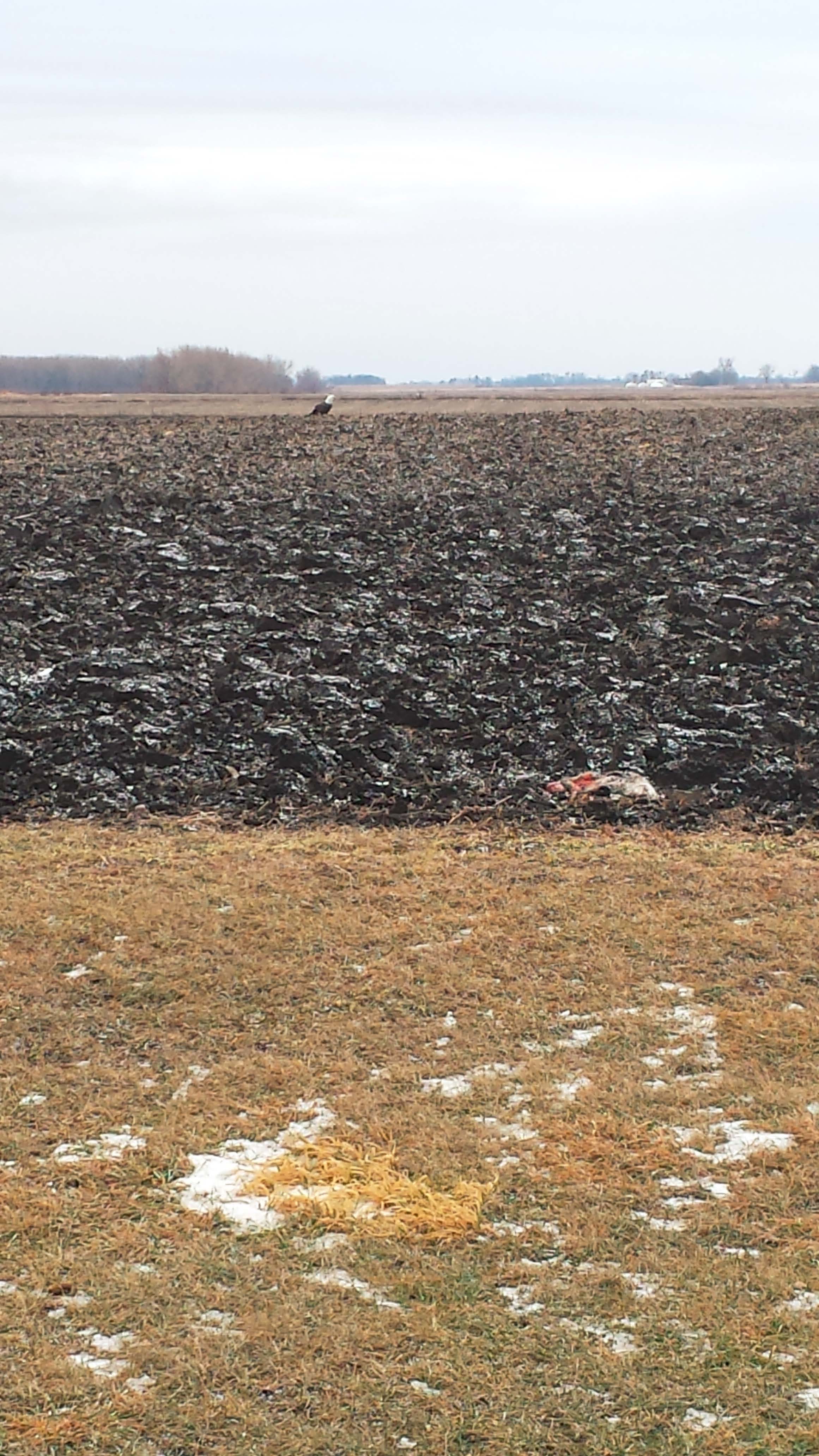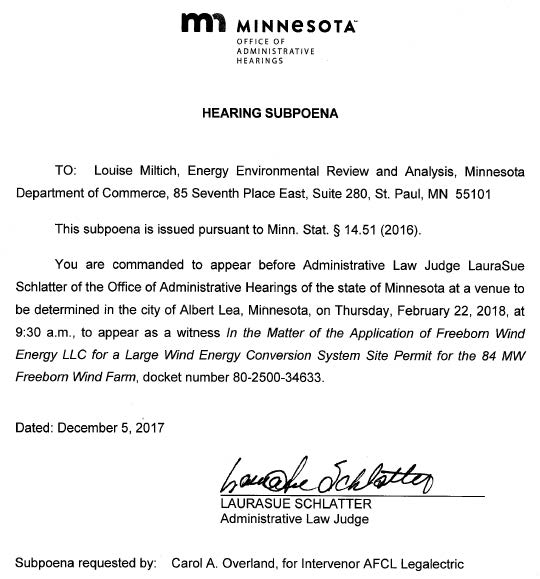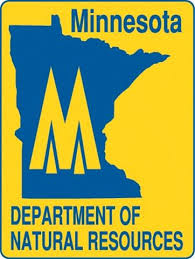Oh yeah, it’s ramping up. Freeborn Wind hearing soon!
February 9th, 2018

Freeborn Wind Project is ramping up.
Photo taken by moi. This is the bald eagle that flew up from the 120th St. ditch as I approached the Hansen home in the Freeborn Wind permit footprint. There’s a nest just a bit to the west, just south of 120th. Guess they don’t want me posting any more eagle photos on their fb page:

And in the news:
Albert Lea City Council Hears Economic Benefits Freeborn Wind Farm
Wind Farm Proposal in Freeborn County
Today, the Department of Natural Resources filed a Motion to Quash so its employees wouldn’t have to appear, filed February 9 regarding Subpoenas that were served December 11 and 18, 2017. Roughly two months ago. After a conversation with DNR Counsel Sherry Enzler where she didn’t want her people sitting around all day so we agreed to a 3 p.m. time, which would need to be locked in with the judge. Now this. Good grief. But our conversation that day was so bizarre that I memorialized it with a letter to the judge, though not in technicolor.
OK, fine, whatever… here we go!
Subpoenas ‘R Us! Association of Freeborn Co. Landowners
February 1st, 2018

Well, Association of Freeborn County Landowners got Subpoenas, served them, and for some reason, the Dept. of Commerce and Dept. of Health really don’t want to bring their reports into the Freeborn Wind docket:
Here are the reports that really matter:
Dept of Health – Public Health Impacts of Wind Turbines
Dept of Health – Comment Pages 59-61 from Siting_InitialFiling_Appendix A_Agency Correspondence
One way or another, these reports WILL get in the record. Why? Well, look at the recommendations in the Dept. of Health comment:


Pretty specific? And the more general recommendations fro the “Public Health Impacts of Wind Turbines” report:

The Dept. of Health report is part of Invenergy’s Roberts’ testimony, but it’s not entered in the record yet. The Dept. of Health 5/2/2017 Comment was part of the Applicant’s Appendix A (pps. 59-61) and again, it’s not part of the record yet. So just making sure it all gets in there one way or another.
Do tell — has the Applicant followed these recommendations of the Minnesota Department of Health in siting their project? Has the Dept. of Commerce followed these recommendations in reviewing the project? Has the Public Utilities Commission followed these recommendations in considering permitting the project?
And what about Commerce? We have documentation that in the Bent Tree project, which had wind noise modeling performed as a part of the application and permitting process, noise modeling which said, “no problem,” and yet (click for larger version):

And the full Bent Tree Noise Monitoring and Noise Report ordered by the Public Utilities Commission.
Commerce filed a Motion to Quash:
And we reached an agreement:
Oh, but wait… they’re really not wanting that Bent Tree info to get in the record! So once more with feeling:
OK, whatever…
And then there’s the Minnesota Department of Health (MDH), and they also jumped on the bandwagon, clearly the Asst. Commissioner who signed the Dept of Health – Comment wasn’t the author and didn’t know much about it (!), so:
Letter and Stipulation for the Release of the Assistant Commissioner
Which leaves the DNR. Got a call from DNR Counsel Sherry Enzler, who clearly didn’t get that Commerce Motion to Quash had no bearing on DNR Subpoena, and that wed reached an agreement and Commerce had withdrawn their Motion, oh my… but anyway, we agreed that we’d set a time certain the last day of the hearing for the DNR staff. No problem… though we’ll need an Order from the judge confirming that.
So on we go…
Oh, but wait, the Applicants, Invenergy, also got their $0.02 in, and filed a Motion:
… OK, again, whatever, gotta get response in on this one…
And may the ALJ decide!!!
The Administrative Law Judge in this case, and the Public Utilities Commission, the ultimate decider, need to recognize that the permitting system is fatally flawed. Prevention, precaution, prudence…
Comment on the St. Croix State Park Draft Management Plan
May 28th, 2017

FYI, there’s a St. Croix State Park Management Plan open for comment, due July 7! Never been to this one, yet, have looked but… Last year after Lindbergh, I sent the DNR a “We’re All Ears” comment about general experiences in the state parks, and this is more specific, so what the hell!! I want to encourage them to have wifi in all the camps, particularly where there’s no phone access. In Michigan, the park way way up at the tip of the peninsula of the UP has WiFi, why can’t we?
Here’s a tour of campsites at St. Croix State Park:
Their page about this plan is HERE.
The DNR will host an open house on June 22, 2017 at the St. Croix Lodge visitor center in St. Croix State Park from 6:30 to 8:00 p.m. to answer questions and collect comments on the draft plan.
And the plan itself? It’s here, check it out:
Draft St. Croix State Park management plan
Comments are due by July 7, and should be sent to:
Jade Templin via email: jade.templin@state.mn.us
MNDNR Division of Parks and Trails
St. Croix Management Plan Comments
500 Lafayette Road Box 39
St. Paul, MN 55155-4039
There’s also a 25 year Parks and Trails Legacy Plan and from that, there’s a Minnesota State Parks and Trails System Plan, and parks are one of three categories, a “Destination” park, a “Core park, or a “Rustic” park. The “Rustic” parks are ones that they say have minimal amenities, but Charles A. Lindbergh, classified as “Rustic,” had great facilities, and even canoes for rent! Anyway, I’m digging through this today because we’re not out camping until later this month.
Check how they’ve categorized the parks in the Parks and Trails Legacy Plan, above. The only one I’d not recommend for any reason is Big Bog, it’s buggy, hot, pretty much just a grassy parking lot, and full of big honkin’ RVs and big honkin’ pick up trucks and big honkin’ boats (it does have docks for most of the campsites). It’s a class thing. UGH!
Destination Parks and Recreation Areas
Bear Head Lake
Forestville/Mystery Cave
Fort Snelling
Gooseberry Falls
Itasca
Jay Cooke
Lake Carlos
Lake Vermilion-Soudan Underground Mine
Mille Lacs Kathio
Sibley
Split Rock Lighthouse
St. Croix
Tettegouche
Whitewater
Wild River
William O’BrienCore/Adventure Parks and Recreation Areas
Banning
Blue Mounds
Cuyuna Country
Interstate
Iron Range OHV
Temperance RiverCore/Gateway Parks and Recreation Areas
Afton
Buffalo River
Camden
Flandreau
Frontenac
Grand Portage
Lake Bemidji
Lake Maria
Maplewood
Minneopa
Myre-Big Island
Nerstrand-Big Woods
Upper Sioux AgencyCore/Classic Parks and Recreation Areas
Big Bog
Big Stone Lake
Cascade River
Crow Wing
Father Hennepin
Fort Ridgely
Glacial Lakes
Glendalough
Great River Bluffs
Hayes Lake
La Salle Lake
Lac Qui Parle
Lake Bronson
Lake Shetek
McCarthy Beach
Moose Lake
Red River
Rice Lake
Sakatah Lake
Savanna Portage
Scenic
Split Rock Creek
Zippel BayRustic Parks
Beaver Creek Valley
Carley
Charles A. Lindbergh
Franz Jevne
Garden Island
George H. Crosby Manitou
Greenleaf Lake
Hill Annex Mine
John A. Latsch
Judge C.R. Magney
Kilen Woods
Lake Louise
Minnesota Valley
Monson Lake
Old Mill
St. Croix Islands
Schoolcraft
The rulemaking process — nothing changes…
September 13th, 2015
Many thanks to the “little birdie” who brought this decades old report to my attention:
Yes, this is a report from the Minnesota Legislative Auditor from 1993, and if you read it, you’ll see little has changed is so many years… The issues raised are issues we’ve been raising in the Public Utilities Commission rulemaking for Minn. R. Ch. 7849 and 7850 (Certificate of Need and Siting/Routing). AAAAAAAAAAAACK!
For example, from the Summary:
For example, in the PUC Rulemaking for 7849 and 7850 (PUC Docket 12-1246), it’s been an over two-year-long process, and few are showing up anymore. We weigh in, some things are taken into account in the drafts, and then that disappears from the next draft. How can it feel like anything but a colossal waste of time? Yet if we weren’t there, the utilities would get everything they want. And as with the utility Certificate of Need and Siting/Routing processes, rulemaking has the same notice and public participation problems. It’s all the same, deja vu all over again.
… and also from the report …
Does this sound familiar?
So what is the bottom line of this report?
Also, we recommend the following additional changes to the Administrative Procedure Act:
… and …
In addition to changing the APA and other statutes that govern agency rulemaking, we recommend that:
Ch. 7829 Rulemaking Comments
July 20th, 2015
Today in the inbox, this DNR Comment on the Chapter 7829 Rulemaking appeared:
Here’s the juicy part:
DOH! Brilliant! So I quick wrote this up and filed a few minutes ago:
Agencies have contributed so much when they show up, and now the DNR and DOT do show up and it’s so much appreciated! How can building the record and getting their comments in be anything but good! Let’s do it!! Let’s establish a distinct status for state agencies to participate in Public Utility Commission dockets!




